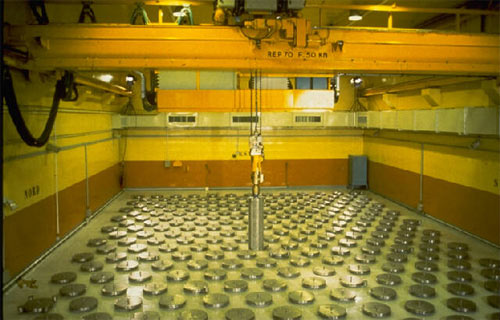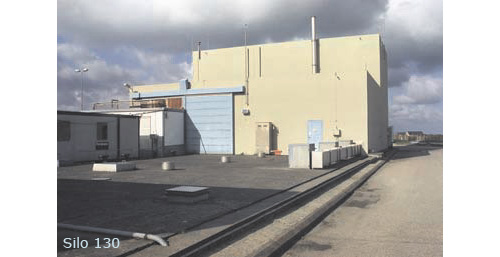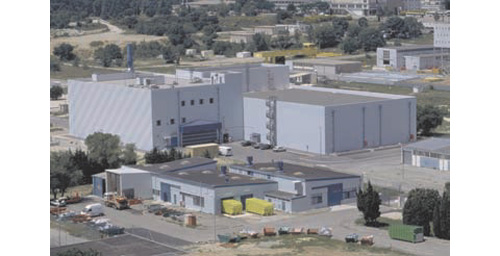Interim waste storage according to their nature and origin

CASCAD bunker in Cadarache
The CASCAD bunker, located inside the CEA research centre in Cadarache, is an interim dry storage facility for irradiated fuel. Fuel elements from the old heavy water plant in Brennilis and from naval propulsion units, which have properties rendering them unsuitable for reprocessing in acceptable technical and economic conditions, are being held in interim storage in this bunker’s shafts.
© DR/CEA
Spent fuel and vitrified waste from Pressurized Water Recators (PWR) reactors are the main sources of radioactive materials requiring interim storage. They have priority due to their very high activity. However, other sources and materials also exist, and interim storage is therefore used for many different types of waste, pending treatment and conditioning or a decision concerning their future disposal.
Beginning with highly radioactive materials, there is spent fuel from now-decommissioned first-generation reactors, reactors operated by national defence and research agencies and prototype reactors such as Superphenix. All these materials have taken a different route to that of spent fuel from current PWR reactors, which makes up the bulk of the total.
Spent fuel from first-generation graphite-gas reactors was the first to be processed, yielding vitrified waste stored in Marcoule. All the waste produced by this obsolete nuclear process must be managed.
Irradiated fuel produced by propulsion reactors in aircraft carriers and nuclear submarines, as well as fuel from the old heavy water plant in Brennilis, has not been reprocessed. It is held in interim dry storage in a bunker at the Cadarache site. The CASCAD bunker was commissioned in June 1990, with a design life of 50 years, making it a medium-term storage facility.

Graphite waste interim storage silo
« Graphite waste » from the okd French natural uranium graphite gas reactors (Uranium Naturel Graphite Gaz – UNGG) is stored in two silos. Silo 130, shown in the photo, is an underground bunker consisting of two 3,000 m3 ventilated cells, only one of which contains waste (approximately 1300 m3, introduced between 1973 and 1990). Silo 115 is a parallelepipedic silo consisting of three ventilated 400 m3 plain steel chambers containing older waste (produced between 1966 and 1974).
© AREVA/ANDRA
The 115 tonnes of irradiated fuel from Superphenix, of which the French share accounts for 75 tonnes, were placed in a cooling pool in a workshop at the Creys Malville facility, which EDF is licensed to operate for 30 years. The fate of this fuel is being considered in parallel to that of the irradiated MOX fuel assemblies currently stored underwater in La Hague.
The long-term future of these high-level materials – in terms of reprocessing, transmutation and geological disposal – is also the subject of research conducted in the light of legislation passed in 1991 and 2006.
Next on the radioactivity scale comes intermediate-level waste (ILW-LL), which under the terms of the aforementioned legislation, is destined for geological disposal. The conditioning adopted for this waste has also evolved to reflect advances in reprocessing techniques. A variety of interim storage arrangements exist accordingly.
The technique consisting in shearing spent fuel cladding and end caps into small pieces in order to compact them is recent. The share of end caps and hulls not sheared and conditions is still in underwater storage in La Hague, whereas conditioned waste (CSD-C) is stored in a compacted container storage building (Entrepôt de Colis Compactés – ECC). Until 1995, these sections were conditioned in drums filled with cement and then stacked. Liquid effluent treatment stations also produce waste that is considered to be ILW-LL and as such must be stored in Marcoule and La Hague.

Multipurpose intermediate storage building (EIP) in Marcoule
The reprocessing techniques currently used in La Hague were originally developed at a facility in Marcoule. Vitrified waste produced are stored here pending disposal. A multipurpose intermediate storage building (EIP) was built for other types of waste, including long-lived intermediate-level waste (ILW-LL). The purpose of the EIP building, which began operating in 2000, is to relocate and centralise miscellaneous interim storage facilities over the period 2003-2020, during which site cleanup operations will be conducted in Marcoule.
© AREVA
Lastly, various interim storage arrangements for low-level long-lived waste (LLW-LL) have been adopted while research is conducted to determine its final destination. This is the case, for example, of legacy graphite waste from natural uranium-graphite-gas (UNGG) reactors, which were shut down several years ago and are in the process of being dismantled. Most of these graphite liners are being held in interim storage in La Hague.
Other articles on the subject « Waste management »
Waste management status
Repositories already in operation for low-level waste Compared with other types of waste, the mas[...]
Temporary storage
A temporary solution Interim storage is a temporary solution that plays a central role in the man[...]
Vitrified waste Storage
Dry storage of vitrified waste Spent nuclear fuel assemblies are not the only materials removed f[...]
Spent fuel storage
Interim storage in pools and then dry locations In all countries, spent fuel management begins wi[...]
Management outside France
Overview of waste management strategies outside France Management of the least radioactive waste [...]
LILW-SL waste repository
Disposal of low and intermediate-level short-lived waste Low and intermediate-level short-lived w[...]
VLLW repository
An operational repository for very low-level waste The second category of waste for which a repos[...]
High level waste transportation
Moving highly radioactive materials The 10% of transport movements that concern high-level radioa[...]
Transport safety
Measures to ensure safe transport Nuclear materials may be highly radioactive. The goal is to pre[...]
Transport-related incidents
Incidents but no accidents… Have radioactive material transport operations caused any accid[...]